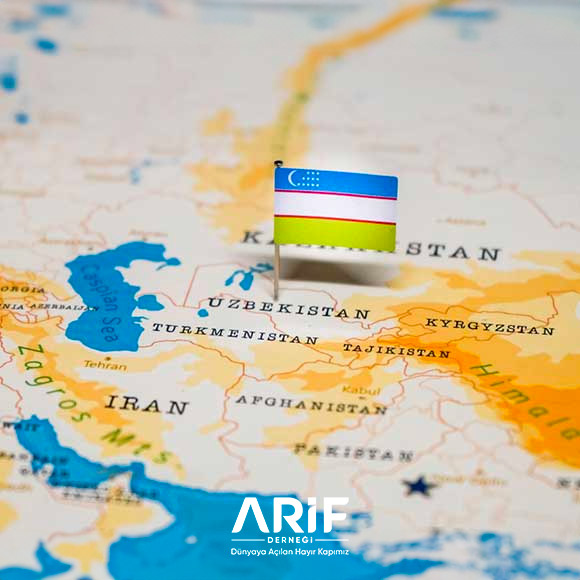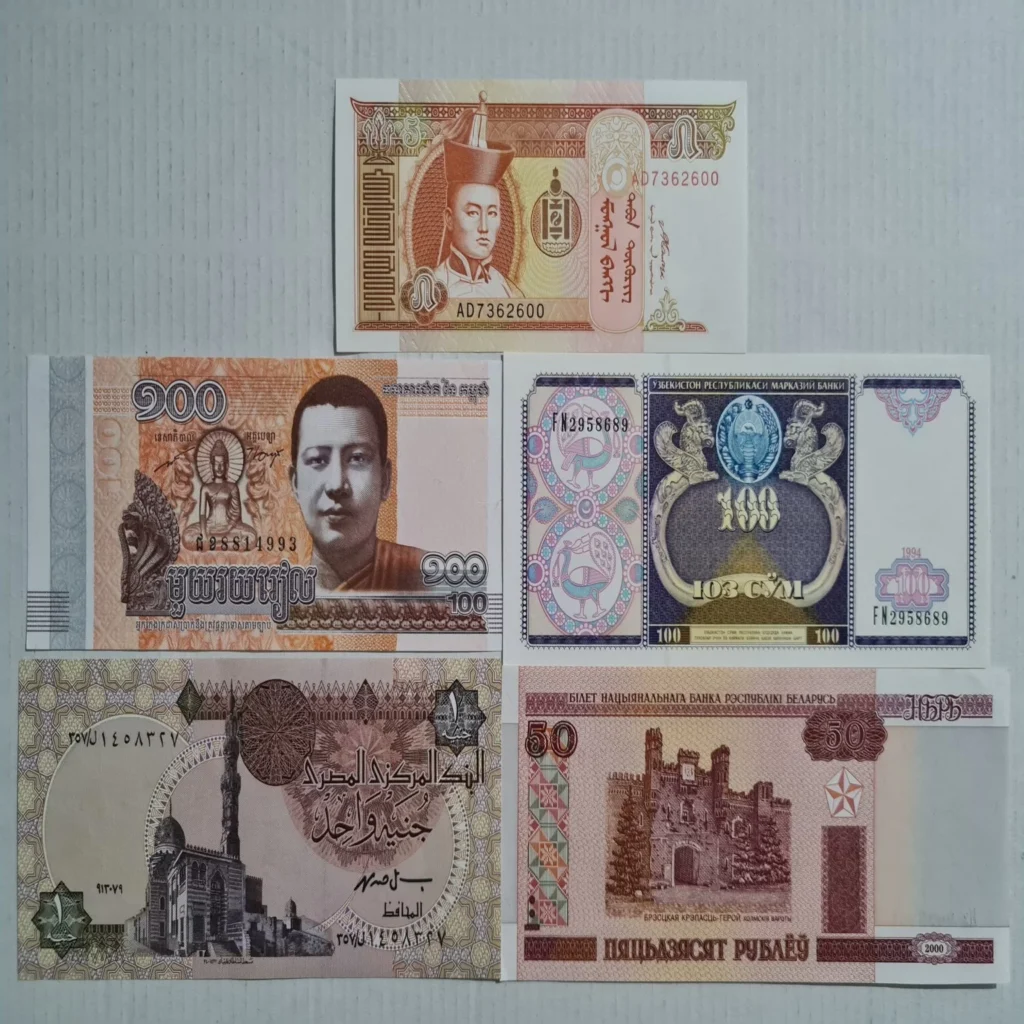Blog
General Information About Uzbekistan

In the north-northwest, Kazakhstan borders, in the east-southeast, Kyrgyzstan and Tajikistan, in the southwest, Turkmenistan, and in the south, Afghanistan. Today, much of the land where Uzbekistan is located was under the rule of the Khiva, Bukhara, and Khokand Khanates in the 19th century.
History
There is no information about the early periods of the history of the Uzbek people. The name ‘Uzbek’ was first given by Ghiyasuddin Muhammad Uzbek, the ruler of the Golden Horde, who reigned between 1313-1340. After the death of Timur Han, the weakening of the Timurid Empire led to the scattering of Uzbeks in the regions north of the Aral Sea and the Syr Darya River. Under the leadership of Abu’l-Khayr, they gathered and declared him their Khan in 1428. Soon, they became stronger and brought other tribes under their control. They captured cities like Sighnaq, Arkuk, Suzak, and Özkent along the Syr Darya River, making Sighnaq their capital. After being defeated by the Kalmyks in military campaigns in the Turkistan region, two leaders named Kanay and Canibek took some Uzbeks with them and sought refuge with the Chagatai Khan. The Uzbeks who left the region were then referred to as Kazak or Kyrgyz Cossacks

After the death of Abu’l-Hayr, the Uzbeks were defeated by Yunus Khan, the Chagatai-Mongol ruler, and scattered. Abu’l-Khayr’s son Shah Budak was killed by Yunus Khan. The scattered Uzbeks gathered around Shah Budak’s son, Muhammad Shaybani (Shaybanid). From this point on, the Uzbeks, also known as the Shaybanids, took advantage of the internal turmoil in the Timurid Empire in 1500, captured Bukhara, and ended the Timurid dynasty. The Uzbeks, who also took control of Khwarezm and Khiva, defeated the Chagatai ruler Babur. By capturing Balkh, Herat, and Tashkent, the Uzbeks became the most powerful state in Central Asia.
Turmoil Period
The Uzbeks were defeated once by the Safavids and lost some territories, but they recaptured them in 1512. Uzbek rule continued throughout the 16th century in Transoxiana. In 1598, six months after the death of the second Abdullah Khan, his son Abdulmumin was killed by his own followers, and the control of the Uzbek state passed to the Canogulları (Astrakhan Khanates), who were relatives of the Shaybanids.
Throughout the 16th century, the Uzbeks fought continuously with the Shiite Safavids in Iran. They tried to establish good relations with the Sunni Ottoman Empire and the Mughal Empire in India. The Uzbeks remained under the control of the Astrakhan Khanate until the middle of the 17th and 18th centuries. In 1740, Nadir Shah destroyed the Astrakhan Khanate.
After Nadir Shah’s death, the rule passed from the Canogulları to the Mangithan dynasty, which continued until 1860. From 1860 onwards, the Uzbeks, who were under the semi-independent rule of the Bukhara Khanate, continued to live under Russian pressures as the Russians advanced further into the interior of Turkistan.
Today, much of the land where Uzbekistan is located was under the control of the Khiva, Bukhara, and Khokand khanates in the 19th century. After the Soviet Revolution of 1917, a temporary government was established where Uzbeks and other Muslims had little say. In December 1917, the Muslim-led government, with Mustafa Chokayev as president, established a national congress in Kokand, but it was overthrown by Russian troops in 1918. Following the coup, a resistance movement known as the Basmachi Rebellion began. The establishment of the Khwarezm and Bukhara Soviet Republics led to the spread of the Basmachi Rebellion. The rebellion lost its strength after the reforms initiated by the Turkestan Commission in 1922.
In 1924, with a border arrangement based on ethnic lines in Central Asia and Kazakhstan, the Khwarezm, Bukhara, and Turkestan republics were dissolved, and the regional territories were divided among Uzbekistan, Tajikistan, Kyrgyzstan, Turkmenistan, and Kazakhstan.
After the modernization movements in the Soviet Union in 1989, Uzbekistan declared its independence in August 1991. It then became part of the Commonwealth of Independent States (CIS)
Physical Structure
The flat and arid western part constitutes the majority of Uzbekistan’s land area. The alluvial Turan Plain in the northwest merges with the Kyzylkum Desert in the south. The Ustyurt Plateau in the west has a gently undulating surface. The region’s most notable features are low mountain ranges, salty marshlands, sinkholes, and caves, along with enclosed basins. The Amu Darya Delta is covered with alluvial soil. A large portion of the Kyzylkum Desert lies within the country. Uzbekistan’s eastern region is mountainous. The mountain ranges forming the western section of the Tianshan Mountains, such as the Ugam, Pskem, Chatkal, and Kuramin ranges, create the rugged terrain. The Fergana Valley, Central Asia’s largest valley, is located in this region.
The most significant lake is the Aral Sea. In addition to the Amu Darya (Ceyhun) and Syr Darya (Seyhun) rivers, there are around 600 small and large rivers.
Climate
Uzbekistan has a very dry continental climate. The annual average rainfall is 200 mm. Summers are long, while winters are short. During summer, temperatures frequently exceed 40°C. In winter, occasional frost occurs.
Natural Resources
Minerals: Uzbekistan is rich in underground resources. There are natural gas deposits in Gazli, Jarkak, and Mubarak; oil in the Fergana Valley and Lower Surhandarya; coal in Angren; copper, zinc, lead, molybdenum in Almalyk and Kaytash; and large gold deposits in Muruntau. The marble extracted from Nurata is famous for its beauty and durability.
Vegetation and Wildlife: Only about 12% of the country’s land is covered with forests. The plains, basins, and foothills in the western part have herbaceous plants, while the hills are home to woody and shrubby plants.
Wildlife in Uzbekistan mainly consists of desert-dwelling animals. Wolves, bears, foxes, gazelles, antelopes, and a variety of birds live in the mountains.
Population and Social Life
Uzbekistan’s population, which reaches 27.6 million, is made up of around 60 different ethnic groups. The population consists of 71.4% Uzbeks, 10.8% Russians, 4% Kazakhs, 3.9% Tajiks, and 9.9% other ethnic groups. Despite rapid urbanization, three-fourths of Uzbeks live in rural areas. The largest ethnic group in Tashkent, the largest settlement in Central Asia, is the Russian population. The major cities of Uzbekistan include Samarkand, Bukhara, Khiva, and Kokand.

Education and Culture
Despite the influence of Russia, education and culture in Uzbekistan have developed significantly. Tashkent University was established in 1920, and today the country is home to 46 universities. In Uzbekistan, where secondary education is mandatory, the literacy rate is close to 100%. The universities in Uzbekistan are major centers of scientific research.
After Russia’s conquest of Uzbekistan, efforts were made to eliminate the national consciousness and religious devotion of the Turkish people. In addition to repression, the most common method used was Russification. The Russification process initially focused on making the Russian language widespread. However, despite these efforts, Muslim Turks did not lose their faith and national feelings. After Uzbekistan declared its independence, religious bans were lifted, and many mosques, prayer halls, and madrassas were opened, with religious activities noticeably increasing.
Samarkand and Bukhara in Uzbekistan have been centers of science and culture throughout history, and their influence continues to this day. Notable scholars and intellectuals such as Biruni, Ulugh Beg, Kadizade-i Rumî, Ali Shir Nevaî, Giyasuddin Cemshid Kashani esh-Shirazi, Ubaydullah-i Akhrar, and Necmeddin-i Kubra were raised in these cities.
Economy
Uzbekistan’s economy is based on industry and agriculture. It is the third-largest cotton producer in the world. Sericulture (silk farming) is also common. The country is known for its grapes. Its climate and vegetation are suitable for cattle and sheep farming, with Karakul sheep being the most widely raised breed in the region.
Uzbekistan is one of Central Asia’s key producers of machinery and heavy equipment. Natural gas extracted from the country is also exported to neighboring republics via pipelines. The most important light industrial products are cotton and silk fabrics. In Muynak, located on the shores of the Aral Sea, caviar, dried, smoked, and salted fish are produced.

Natural Resources
Uzbekistan is rich in natural resources. The abundant natural gas, gold, and uranium deposits in the Navoi region have contributed to the rapid development of the area. Cement factories, large chemical industries, and power plants have been established in the region. At the Muruntau gold mine in Zarafshan, approximately 80 tons of gold are extracted annually, a production level higher than the output of the largest gold mines in the world. The extracted minerals are processed in the regional capital, Navoi.
Post-Independence
After gaining independence, Uzbekistan forged close diplomatic ties with Turkey. The two countries signed agreements covering areas such as economy, trade, credit, tourism, and culture.
Although Uzbekistan remained independent after the dissolution of the Soviet Union, it lacked the infrastructure and capabilities to manage its own industry. As a result, it became a member of the Commonwealth of Independent States (CIS), along with Russia, Ukraine, and Belarus. However, in an effort to build its own economy, Uzbekistan joined organizations within the Bretton Woods system (such as the IMF and World Bank). Despite adopting policies from these organizations, especially the IMF, Uzbekistan has implemented privatization more slowly than other Central Asian states. The privatized institutions were mostly service sector enterprises, while industrial enterprises generally remained under state control. This approach has helped Uzbekistan experience lower unemployment rates compared to other nations in the region. Although the delay in privatizing industrial sectors has limited foreign investments, Uzbekistan’s current situation is more favorable than that of other Central Asian countries (with the exception of Kazakhstan).

Natural Resources and Agriculture
Uzbekistan ranks among the top gold producers in the world with an annual production of 80 tons. Copper reserves are estimated at 800 million tons, and coal production reaches 6 million tons per year.
The country has a continental climate, making only 9% of its land suitable for agriculture. Cotton plays a significant role in the economy, with Uzbekistan being the fourth-largest cotton producer in the world. In addition to cotton, Uzbek farmers grow wheat, fruits, vegetables, silk, and rice. Agriculture remains the dominant sector in the economy.
Approximately 30% of the population works in agriculture, and agricultural production is carried out through kolkhozes, sovkhozes, and meshkhozes (state-run organizations).
Livestock and Industry
Livestock is also an important part of Uzbekistan’s economy. The country has cattle, sheep, goats, and poultry. According to data from 1994, annual wool production is around 20,000 tons. Astrakhan fur sheep farming has become particularly significant, with exports playing a key role. Uzbekistan’s industry is primarily petrochemical, with an annual fertilizer production of 1.5 million tons. Additionally, the chemical industry has grown in connection with cotton production.
As of 1990, the breakdown of the economy was as follows: Industry (35%), Agriculture (34%), Construction (14%), Transportation (5%), and Other sectors (12%).
Light industry products mainly consist of silk and cotton fabrics, with facilities for livestock production and processing located along the shores of the Aral Sea.
Transportation
Uzbekistan’s transportation network includes a 3,000 km railway connecting major cities like Tashkent, Samarkand, Bukhara, Charjuy, and Fergana, as well as 21,500 km of highways. The Amu Darya river is navigable for 1,200 km. The country has airports in many cities, facilitating air travel.
